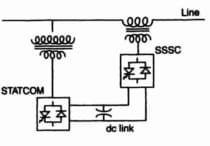1. Transmission line connects__________.
a. Generating station to a switching station/ step down transformer
station
b. Step-down transformer station to service transformer banks
c. Distribution transformer to consumer premises
d. Service points to consumer premises
2. A 3-phase, 4-wire system is commonly used for__________.
a. Primary distribution
b. Secondary distribution
c. Primary transmission
d. Secondary transmission
3. The rated voltage of 3-phase power system is given as_________.
a. RMS phase voltage
b. Peak phase voltage
c. RMS line to line voltage
d. Peak line to line voltage
4. Which of the following is usually not the generating voltage ?
a. 6.6 kV
b. 9.9 kV
c. 11 kV
d. 13.2 kV
5. In a transmission system the feeder supplies power to________.
a. Transformer sub-station(step-up)
b. Service mains
c. Distributors
d. All of the above
6. Feeder is designed mainly from the point of view of__________.
a. Its current carrying capacity
b. Voltage drop in it
c. Operating voltage
d. Operating frequency
7. Distributors are designed from the point of view of__________.
a. Its current carrying capacity
b. Voltage drop in it
c. Operating voltage
d. Operating frequency
8. Transmission and distribution of electric power by underground system is superior to overhead system in respect of________.
a. Appearance and public safety
b. Maintenance cost
c. Frequency of faults, power failure and accidents
d. All of the above
9. The main drawback(s) of underground system over overhead system is/are ___________.
a. Exposure to lightning
b. Heavy initial cost
c. Exposure to atmospheric hazards such as smoke, ice, wind, etc.
d. Inductive interference between power and communication circuits
10. The main drawback(s) of overhead system over underground system is/are ___________.
a. Underground system is more flexible than overhead system
b. Higher charging current
c. Surge problem
d. High initial cost
11. By increasing the transmission voltage double of its original value, the same power can be despatched keeping the line loss___________.
a. Equal to its original value
b. Half of original value
c. Double the original value
d. One-fourth of original value
12. If a fixed amount of power is to be transmitted over certain length with fixed power loss, it can be said that volume of conductor is_________.
a. Inversely proportional to magnitude of the voltage and that of power factor of the load
b. Inversely proportional to square of the voltage and square of power
factor of the load
c. Proportional to square of voltage and that of power factor of the load
d. Proportional to magnitude of the village only
13. For the same voltage drop, increasing the voltage of distributor n-times________.
a. Reduces the x-section of the conductor by n times
b. Increases the x-section of the conductor by n times
c. Reduces the x-section of the conductor by n2 times
d. Increases the x-section of the conductor by n2 times
14. In a transmission system, the weight of copper used is proportional to__________.
a. E2
b. E
c. 1/E2
d. 1/E
15. The volume of copper required for an ac transmission line is inversely proportional to________.
a. Current
b. Voltage
c. pf
d. Both (b) and (c)
a. Reduces the current for given output
b. Increases losses in line
c. Inversely proportional to
the square of voltage and pf of the load
d. Directly proportional to the square of the voltage and pf of the load
18. For the same conductor length, same amount of power, same losses and same maximum voltage to earth, which system require minimum conductor area?
a. Single phase ac
b. 3 phase ac
c. 2 wire ac
d. 3 wire dc
a. Single phase, 2-wire system
b. 2-phase, 3-wire system
c. 3-phase, 3-wire system
d. 3-phase, 4-wire system
a. Reduction in transmission
losses
b. Reduction in time of transmission
c. Increase in system reliability
d. None of the above
21. The maximum tension in a section of overhead line conductor between two supports of unequal height occurs at_______.
a. The higher support
b. The lower point
c. The midpoint of the conductor
d. None of the above
22. Stringing chart is useful_______.
a. For finding the sag in the conductor
b. In the design of tower
c. In the design of insulator string
d. Finding the distance between towers
23. Hot template curves are plots of________.
a. Temperature and humidity
b. Conductor sag and span lengths
c. Conductor weight and sag
d. None of the above
24. The effect of wind pressure is more predominant on________.
a. Insulators
b. transmission lines
c. Supporting towers
d. None of the above
25. Galloping in transmission line conductors arises due to__________.
a. Asymmetrical layers of ice
formation
b. Vortex phenomenon in light winds
c. Heavy weight of the line conductors
d. Adoption of the horizontal conductor configuration
Transmission and Distribution line MCQ Part-2
Transmission and Distribution line MCQ Part-3
Transmission and Distribution line MCQ Part-4
Transmission and Distribution line MCQ Part-5





0 Comments
If you have any doubt, feel free to ask.